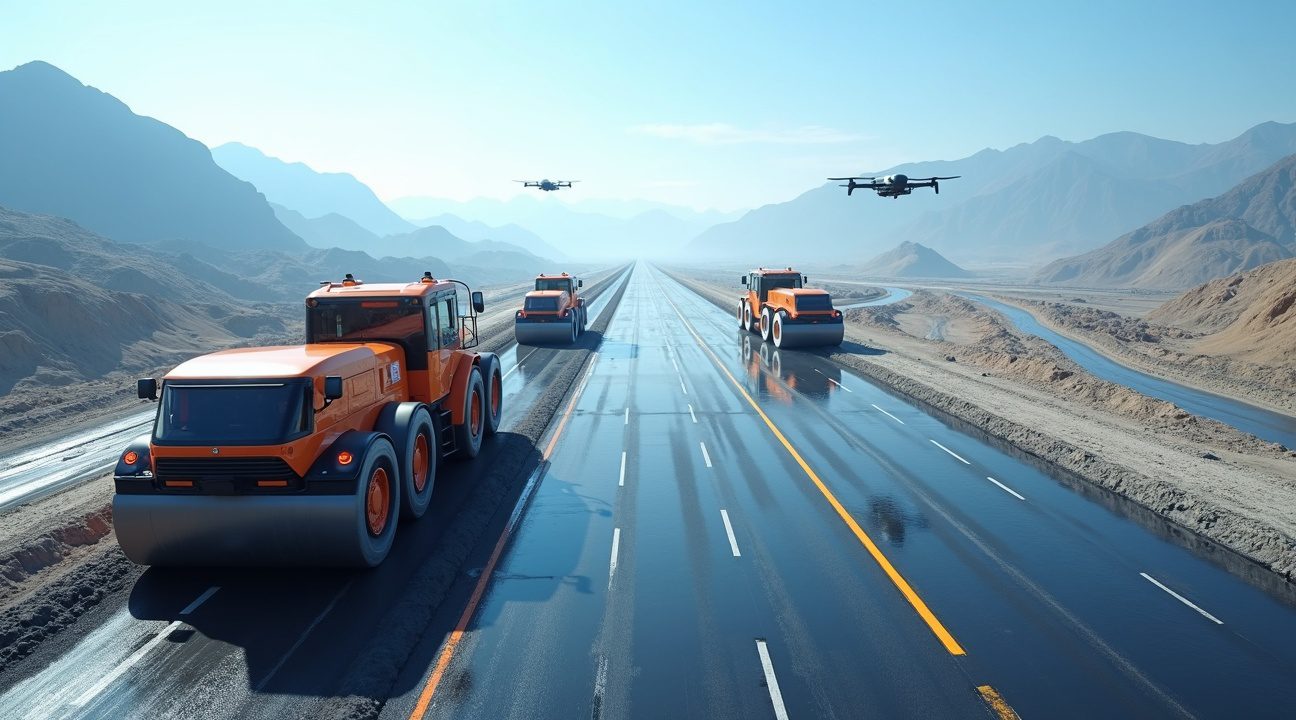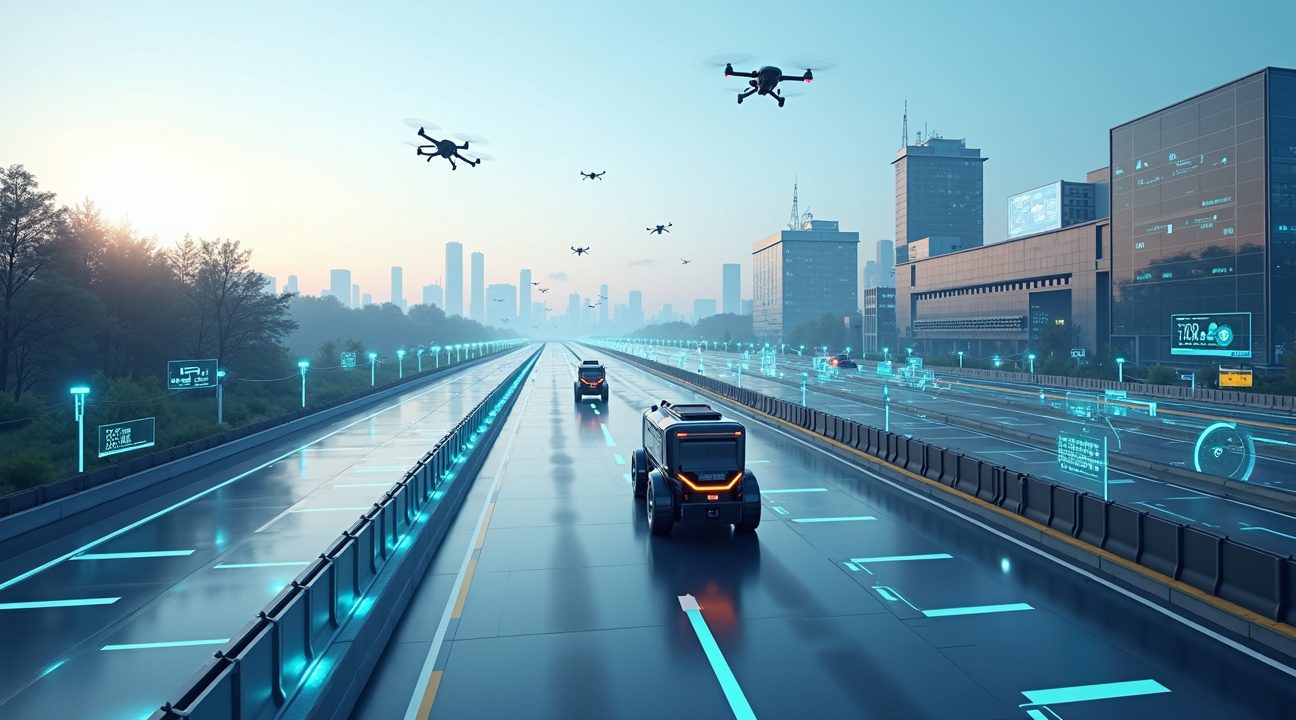China has achieved a historic milestone in autonomous construction by completing the world’s first entirely unmanned highway resurfacing project, covering 158 kilometers of the Beijing–Hong Kong–Macao Expressway without a single on-site human worker.
Key Takeaways
- Revolutionary Scale: China completed the largest unmanned construction project ever attempted, resurfacing 158 kilometers of highway using only AI-guided robots and drones with no human workers present on-site.
- Advanced Technology Integration: The project employed sophisticated AI-controlled fleets including unmanned pavers, rollers, and surveillance drones that achieved millimeter-level precision through GPS and Beidou positioning systems.
- Enhanced Safety and Efficiency: Eliminating human workers from the construction site removed all traditional safety risks while enabling continuous 24/7 operations without breaks, weather delays, or fatigue-related issues.
- Superior Quality Control: Automated systems delivered consistent, high-quality results across the entire project with zero-trimming errors, creating smoother road surfaces with fewer joints and enhanced durability compared to traditional construction methods.
- Global Leadership Position: This achievement places China significantly ahead of other nations in autonomous construction technology, while the European Union, United States, and Japan continue to experiment with only partial automation and smaller-scale pilot projects.
To learn more about this cutting-edge achievement and autonomous construction technologies, visit the Global Times report.
World’s First Fully Unmanned Highway Project Sets Revolutionary Precedent
China has achieved a monumental breakthrough in construction technology by completing the world’s first fully unmanned highway resurfacing project. The country successfully renovated 157.79 kilometers of the Beijing–Hong Kong–Macao Expressway using exclusively AI-guided robots and drones, with absolutely zero human workers present on-site during the entire operation.
This groundbreaking project represents a paradigm shift in large-scale infrastructure development. Traditional highway construction typically requires hundreds of workers, extensive safety protocols, and significant logistical coordination to manage human resources across vast stretches of roadway. By eliminating the human element entirely, China has demonstrated that autonomous heavy machinery can handle complex construction tasks with unprecedented precision and efficiency.
Revolutionary Scale and Precision Technology
The Beijing–Hong Kong–Macao Expressway project stands as the largest unmanned construction undertaking ever completed globally. AI-guided robots managed every aspect of the resurfacing process, from removing old asphalt to laying new materials with millimeter-level accuracy. These machines operated continuously without breaks, weather-related delays, or safety concerns that typically plague human-operated construction sites.
Drone-based construction played a crucial supporting role throughout the project. Flying units conducted real-time quality inspections, monitored progress across the entire 158-kilometer stretch, and coordinated communication between different robotic systems. The drones ensured consistent quality standards while providing comprehensive oversight that would be impossible for human supervisors to achieve across such an extensive area.
Safety and Efficiency Benefits Transform Construction Standards
The absence of on-site workers eliminated virtually all construction-related safety risks that plague traditional highway projects. Construction zones typically present significant hazards, including:
- Vehicle collisions involving work crews
- Equipment-related injuries from heavy machinery operation
- Exposure to hazardous materials and extreme weather conditions
- Fatigue-related accidents during extended work periods
Smart infrastructure systems enabled the autonomous machines to operate around the clock without human intervention. This continuous operation schedule compressed what would typically be a multi-month project into a significantly shorter timeframe. The AI systems optimized workflow patterns, material usage, and equipment positioning to maximize efficiency while maintaining quality standards that exceed traditional construction methods.
The project’s success has profound implications for future infrastructure development worldwide. Other countries are already studying China’s approach to determine how similar drone-based construction methods might be adapted for their own projects. The technology demonstrates that complex, large-scale construction can be completed faster, safer, and potentially more cost-effectively than traditional approaches.
This achievement builds upon China’s broader commitment to automation and artificial intelligence in infrastructure development. The country has been investing heavily in robotic construction technologies, and this highway project represents the culmination of years of research and development in autonomous systems. The success opens possibilities for applying similar approaches to bridge construction, tunnel boring, and other major infrastructure projects that traditionally require significant human labor.
The unmanned resurfacing project also showcases how AI can coordinate multiple types of machinery simultaneously. Different robotic systems handled specific tasks while maintaining perfect synchronization across the entire work area. This level of coordination would be extremely challenging for human operators to achieve, particularly across such an extensive geographic area.
Construction companies worldwide are now examining how they might integrate similar technologies into their operations. The Beijing–Hong Kong–Macao Expressway project proves that fully autonomous construction is not just theoretically possible but practically achievable on a massive scale. As these technologies become more refined and accessible, they could fundamentally reshape how major infrastructure projects are planned and executed globally.
Advanced AI Fleet and Precision Technology Transform Construction Methods
The remarkable highway project utilized a sophisticated fleet of autonomous vehicles that redefined construction capabilities. Sany Heavy Industry’s SAP200C-10 unmanned paver served as the flagship machine, capable of laying 19.25 meters of asphalt in a single pass—significantly wider than conventional equipment. This robotic paver worked alongside six 13-tonne double-drum rollers and three 30-tonne rubber-wheel rollers, all operating without human operators on-site.
Precision positioning technology formed the backbone of this operation. Drones equipped with high-resolution cameras performed comprehensive mapping, identified work zones, and maintained continuous surveillance throughout the project. These aerial units leveraged both GPS and China’s Beidou positioning system to achieve centimeter-level accuracy, ensuring every measurement met exacting standards. The integration of multiple positioning systems eliminated the margin for error that typically plagues large-scale construction projects.
Synchronized Operations Through AI Control Systems
Sophisticated AI-based control algorithms orchestrated the entire fleet through a low-latency management network. These systems handled real-time path planning, synchronized the rolling operations, and implemented adaptive responses that automatically corrected for surface irregularities and compaction variations. The autonomous rollers followed predetermined patterns while continuously adjusting their operations based on real-time data from sensors and drone feedback.
The technology achieved zero-trimming errors and millimeter precision paving through advanced tracking systems, particularly impressive at road edges where manual operations typically struggle. Each machine communicated with the others, creating a synchronized dance of construction equipment that operated with unprecedented precision. This level of coordination mirrors advances I’ve observed in other autonomous systems, from adaptive robotics to self-driving vehicles.
The AI fleet management system processed massive amounts of data in real-time, making split-second decisions about speed, pressure, and positioning. This approach eliminated human error while maintaining consistent quality across the entire 158-kilometer stretch. The combination of drone mapping technology and ground-based sensors created a comprehensive monitoring system that resembles innovations in smart sensing technology, demonstrating how AI integration transforms traditional industries through precision automation.

Complete Elimination of Human Workers Creates Unprecedented Safety Standards
The highway resurfacing project achieved something remarkable—zero human workers stepped foot on the actual construction site. Human oversight shifted entirely to centralized control rooms, where engineers monitored operations from safe, climate-controlled environments miles away from heavy machinery and hazardous materials. This approach eliminated traditional construction risks like equipment accidents, exposure to asphalt fumes, and weather-related injuries that plague conventional road work.
Advanced safety systems replaced human presence with sophisticated technology. Electronic fences created virtual barriers around work zones, while emergency stop mechanisms could halt all operations instantly if sensors detected potential problems. Real-time obstacle detection systems continuously scanned for unexpected hazards, from stray animals to debris, automatically adjusting machine paths without human intervention. AI-guided robots processed environmental data faster than any human operator could react, making split-second decisions that prevented accidents before they occurred.
Labor Transformation and Workforce Evolution
Automation fundamentally changed what construction workers do rather than simply replacing them. Engineers now spend their time programming robotic systems, optimizing AI algorithms, and analyzing performance data instead of operating heavy machinery directly. The project required skilled technicians to:
- Monitor multiple robotic units simultaneously through digital dashboards
- Troubleshoot software issues and mechanical problems remotely
- Analyze real-time data streams to improve system efficiency
- Coordinate fleet movements across different highway sections
- Maintain and calibrate precision equipment between operations
Remote supervision became the new norm, with operators managing entire construction fleets from command centers equipped with multiple screens, sensor feeds, and communication systems. Workers developed skills in robotics operation, data interpretation, and system maintenance—capabilities that transfer across industries as automation expands. This workforce reskilling represents a significant shift from physical labor toward technical expertise and problem-solving roles.
The technology demonstrates how autonomous systems can handle complex tasks while maintaining safety standards that exceed traditional human-operated projects. Emergency protocols activate automatically when sensors detect anomalies, while predictive maintenance algorithms prevent equipment failures before they occur. Machine learning systems continuously improve performance by analyzing successful operations and identifying potential improvements.
Labor automation in construction extends beyond simple task replacement. Teams now focus on strategic planning, quality control, and system optimization rather than manual execution. This transformation requires significant training investments but produces workers with valuable technical skills applicable across multiple industries. The project proves that automation can enhance worker safety while creating new career paths that emphasize cognitive skills over physical endurance.
Human expertise remains crucial, just redirected toward higher-level functions. Operators make strategic decisions about routing, timing, and resource allocation while machines handle precise execution. Quality assurance teams analyze output data to ensure specifications are met, while maintenance specialists keep robotic systems operating at peak efficiency. The result is a safer, more efficient construction process that protects workers while delivering superior results.
Similar to how smart glasses provide remote visual assistance, construction teams now rely on digital interfaces and sensor networks to maintain complete situational awareness without physical presence. This approach minimizes exposure to dangerous conditions while maximizing operational control and safety oversight.

Superior Quality and Efficiency Deliver Measurable Construction Advantages
This revolutionary approach to highway construction demonstrates how artificial intelligence and automation can transform infrastructure projects. The 158-kilometer highway project showcased construction efficiency gains that traditional methods simply can’t match, with work proceeding around the clock without human fatigue limitations affecting quality or safety.
Accelerated Timelines and Continuous Operations
Project speed increased dramatically because AI-guided robots and drones operated continuously without breaks, shift changes, or weather-related delays that typically plague conventional construction crews. The automated systems worked through nights and weekends, maintaining consistent productivity levels that human workers can’t sustain over extended periods. This uninterrupted workflow compressed typical construction schedules by significant margins.
Quality control reached unprecedented levels through precision automation that eliminates human error from critical processes. The robotic systems achieved superior material compaction compared to traditional machinery, creating denser, more durable road surfaces with enhanced longevity. Computer-controlled equipment ensured perfect evenness across the entire surface, reducing variations that typically occur with human-operated machinery.
The automated construction process produced remarkably smooth road surfaces with fewer joints, directly addressing common failure points in traditional highway construction. Fewer joints mean reduced risk of future potholes, cracks, and other structural weaknesses that plague conventionally built roads. This improvement in road durability translates to lower maintenance costs and extended service life for the infrastructure investment.
Cost-Effectiveness Through Reduced Labor and Waste
Long-term savings emerge despite the substantial initial investment required for robotics and AI systems. The technology eliminates costly construction errors that frequently occur in manual operations, where human judgment and physical limitations can compromise precision. Reduced labor costs become significant over large-scale projects, as automated systems replace numerous skilled workers while maintaining higher quality standards.
Accelerated project timelines generate additional economic benefits beyond direct construction savings. Faster completion reduces traffic disruption periods, minimizing economic losses from detours and delays that affect regional commerce. The efficiency gains compound when applied across multiple infrastructure projects, creating a scalable advantage for large-scale development programs.
Material waste decreases substantially through precise automated application and measurement systems. Advanced robotics calculate exact material requirements and apply them with minimal waste, unlike manual processes where human estimation often leads to excess usage or insufficient coverage requiring costly corrections.
Performance in Challenging Environments
The technology demonstrates particular value in challenging environments where human workers face safety risks or productivity limitations. Extreme weather conditions, hazardous terrain, or remote locations don’t impair robotic performance the way they affect human crews. This capability extends construction seasons and enables work in previously inaccessible areas.
Quality consistency across the entire project represents another measurable advantage. Human workers experience fatigue, attention lapses, and skill variations that create inconsistencies in finished work. Automated systems maintain identical precision from the first kilometer to the last, ensuring uniform quality throughout the project.
The integration of autonomous vehicles and smart monitoring systems creates comprehensive project oversight that identifies and corrects issues immediately rather than discovering problems during final inspections. Real-time data collection enables continuous optimization of construction processes, further enhancing efficiency and quality outcomes.
Conclusion: A Blueprint for the Future
These technological advances position automated construction as a superior alternative to traditional methods, delivering measurable improvements in speed, quality, and cost-effectiveness. The success of this highway project establishes a blueprint for future infrastructure development that prioritizes efficiency and durability through intelligent automation.
China’s Vision for Nationwide Intelligent Infrastructure Network
China’s ambitious highway resurfacing project represents just the beginning of a much larger transformation. I see this initiative as a blueprint for developing smart infrastructure across the entire nation, extending far beyond road construction to encompass bridges, tunnels, and comprehensive urban development projects.
This pioneering approach has captured international attention, with the European Union, Japan, and the United States actively studying China’s methods. These regions recognize the potential for AI-driven construction technologies to revolutionize their own infrastructure programs. The success of autonomous construction methods demonstrates how digital twins and advanced robotics can deliver unprecedented precision and efficiency in large-scale projects.
However, implementing this vision faces significant obstacles that require careful consideration. High entry costs present the most immediate barrier, as the sophisticated technology demands substantial upfront investment. The integration of AI systems, autonomous vehicles, and precision robotics requires financial commitments that many regions struggle to justify, particularly when traditional construction methods remain familiar and accessible.
Addressing Implementation Challenges
Public skepticism poses another substantial hurdle that governments must address through transparent communication and demonstrated results. Many citizens question the reliability of fully automated construction processes, particularly when safety and long-term durability are at stake. Building trust requires consistent performance data and clear evidence that these technologies deliver superior outcomes compared to conventional approaches.
The most pressing concern involves workforce development and the urgent need for comprehensive retraining programs. Construction workers who’ve spent decades mastering manual labor techniques must transition to tech-centric roles that emphasize system monitoring, data analysis, and equipment maintenance. This shift demands significant investment in education and creates temporary unemployment challenges that policymakers must address proactively.
Key areas that require focused solutions include:
- Workforce retraining: Building new educational pathways for AI and robotics-focused construction careers.
- Public communication: Informing the public of automation benefits through transparency and case studies.
- Regulatory reform: Updating safety standards to accommodate non-human operators and smart machinery.
Policy adaptation becomes crucial as governments work to establish regulatory frameworks for autonomous construction technologies. Current building codes and safety regulations weren’t designed for robotic systems operating without human oversight, requiring comprehensive updates to legal structures and quality assurance protocols.
China’s model demonstrates that successful implementation requires coordination between government agencies, technology companies, and educational institutions. The integration of construction innovation with existing infrastructure systems demands careful planning and phased deployment strategies that minimize disruption while maximizing technological benefits.
The future of intelligent infrastructure networks depends on addressing these challenges systematically while maintaining focus on the long-term benefits of autonomous construction technologies. Countries that successfully adapt their policies and invest in workforce development will likely lead the next generation of smart infrastructure development.

Global Comparison Reveals China’s Massive Lead in Autonomous Construction
China’s 158-kilometer autonomous highway project dwarfs anything currently happening in Western countries and Japan. While other nations experiment with partial automation, China has delivered a complete, operational solution that eliminates human workers from the construction site entirely.
Limited Progress in Western Markets
European Union and UK construction companies currently deploy semi-autonomous systems for specific tasks, but their scope remains narrow. Drone surveys and automated material placement represent the extent of their automation efforts. These pilot projects typically cover just a few kilometers at most, focusing on proof-of-concept rather than large-scale implementation.
The United States follows a similar pattern, with companies testing individual automated components like self-driving vehicles for material transport and robotic equipment for precise placement tasks. However, no American project has achieved 100% unmanned operation across an entire construction timeline. Research institutions collaborate with construction firms to develop these technologies, but practical deployment remains years away.
Japan’s approach emphasizes precision robotics and advanced sensing technologies, yet their projects maintain significant human oversight. Construction robots handle repetitive tasks while human operators monitor progress and make critical decisions. Full automation stays confined to laboratory environments and small-scale demonstrations.
Setting the Global Benchmark
China’s achievement establishes new standards for what’s possible in construction automation. The project’s success demonstrates that current technology can handle complex terrain variations, weather conditions, and quality control requirements without human intervention. This breakthrough forces other nations to reconsider their incremental approaches to construction automation.
The gap between China’s capabilities and international efforts highlights different philosophical approaches to technology adoption. While Western countries prioritize gradual implementation with extensive safety testing, China has committed to rapid, large-scale deployment of advanced robotics solutions.
Construction industry leaders worldwide now face pressure to accelerate their automation programs. The proven effectiveness of fully autonomous construction on such a massive scale provides a roadmap for future projects. Countries that lag behind risk losing competitive advantages in infrastructure development speed and cost efficiency.
This groundbreaking project signals a shift in global construction capabilities. Traditional methods requiring large human workforces may become obsolete as autonomous systems prove their reliability and efficiency. The 158-kilometer highway serves as proof that the future of construction has arrived, with China leading the charge into this new era of smart technology integration.
https://www.youtube.com/watch?v=gc19G6ZuNI4

Sources:
HighwaysIndustry.com: “China Just Resurfaced 158 km of Highway Using Only Robots and Drones”
Sparknify: “When Robots Pave the Road: The New Era of Infrastructure [Video]”
BeyondTheBuild: “China Just Built 157 km of Highway Without Humans – YouTube”
Europe of Cities: “A Safer Future for Roadwork? China’s Autonomous Machines Complete 158 km Highway”
Structrum Limited: “AI, Drones, and Robots Resurfacing 158km Highway in China”
JobToRob (YouTube): “China has constructed a 160 kilometer highway exclusively using drones and robots!”


